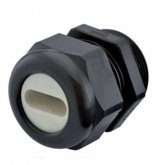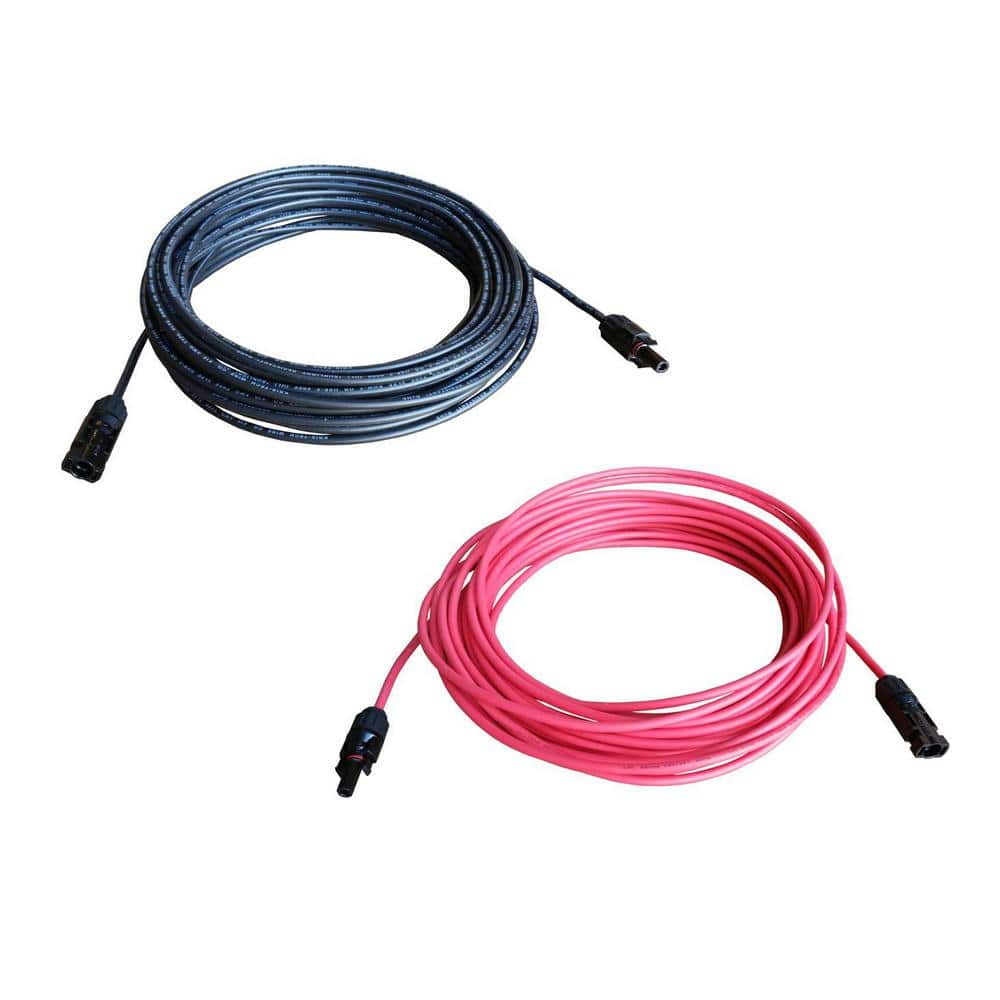You are using an out of date browser. It may not display this or other websites correctly.
You should upgrade or use an alternative browser.
You should upgrade or use an alternative browser.
Making 8AWG PV to SCC wires
- Thread starter Spleeft
- Start date
Spleeft
New Member
- Joined
- Jan 22, 2020
- Messages
- 46
Making 8AWG wires with MC4 connectors is not something anyone does....ok, and after searching combiner boxes it looks like they are used in larger systems, ( I'm only looking at 4 100w 2s2p on my RV roof ) , maybe I dont need 8AWG.....its just a long wire run. thnx for the reply cass !!!
JeepHammer
Solar Wizard
- Joined
- Nov 15, 2019
- Messages
- 1,149
Un-insulated/Non-insulated 8Ga terminals, Heat shrink for insulation if you need it,
And a 8-4Ga crimp tool.
Order 'Closed Barrel', they will be soldered/welded shut and won't spread/open when crimped.
MC4 connectors are only good to 20A, 10Ga wire is good to 32A.
Some people will tell you MC4 is good to 30A, but that's NOT what code says.
See a problem here?
8Ga is solid to 46A, so someone running parallel panels should consider 8Ga.
I also use tinned marine wire for outdoor use, cuts down on those annoying corrosion problems.
'Primary' wire insulation is good to 60V,
8Ga tinned comes with 600V insulation also but most people on this forum won't need the 600V version unless they are trying to pass code, mostly small systems here, but it's good to know when the code monster gets on your butt.
And a 8-4Ga crimp tool.
Order 'Closed Barrel', they will be soldered/welded shut and won't spread/open when crimped.
IWISS Ratchet Crimping Tool for Non-Insulated Terminals from AWG 22-6 with for sale online | eBay
Find many great new & used options and get the best deals for IWISS Ratchet Crimping Tool for Non-Insulated Terminals from AWG 22-6 with at the best online prices at eBay! Free shipping for many products!
www.ebay.com
MC4 connectors are only good to 20A, 10Ga wire is good to 32A.
Some people will tell you MC4 is good to 30A, but that's NOT what code says.
See a problem here?
8Ga is solid to 46A, so someone running parallel panels should consider 8Ga.
I also use tinned marine wire for outdoor use, cuts down on those annoying corrosion problems.
'Primary' wire insulation is good to 60V,
8Ga tinned comes with 600V insulation also but most people on this forum won't need the 600V version unless they are trying to pass code, mostly small systems here, but it's good to know when the code monster gets on your butt.
Last edited:
Combiner can be a broad range of build. Innanother thread we are talking about an outdoor enclosure as inexpensive as possible.
I could easily place a short piece of din rail inside a 4" ×4" ×2-1/2" or 3" deep pvc outdoor rated enclosure, junction box. On the din rail could be breakers or feedthrough terminal blocks with jump bus between them or a bus and lug terminated in a row of them. Compact and cheap i do it often.
I could easily place a short piece of din rail inside a 4" ×4" ×2-1/2" or 3" deep pvc outdoor rated enclosure, junction box. On the din rail could be breakers or feedthrough terminal blocks with jump bus between them or a bus and lug terminated in a row of them. Compact and cheap i do it often.
offgriddle
"FOREVER BEGINNING"
You could always crimp a 6" length of 10 gauge wire into the mc4, then use a larger splice on the other end of the 6" 10 gauge that would accommodate the 8 gauge. Just crimp down real good on the 10 gauge end of the splice. A standard electrical crimp tool available in the electrical section should work just fine. Use good quality waterproof heatshrink tubing and viola!Im considering going with 8AWG PV to SCC wires instead of 10AWG. But all of the crimping tools and MC4 connectors only go up to 10AWG. How are you'all making your 8AWG wires?
JeepHammer
Solar Wizard
- Joined
- Nov 15, 2019
- Messages
- 1,149
Screwed up the edit, see below.
Last edited:
JeepHammer
Solar Wizard
- Joined
- Nov 15, 2019
- Messages
- 1,149
If you can wait a month,

If you want one in a week,

The strain relief/water stopper is called a 'Cable Gland', all number of wires, all shapes wire comes in.
Romex oval, Google 'Oval Cable Gland' and this pops up, what I like to use for tinned marine wire with a jacket, looks like Romex but with only two conductors in the jacket.

Makes for a tidy install.

Enclosure Waterproof Case Electrical Junction Box Connector Terminal Wire Cable | eBay
Waterproof Junction Box only, other accessories demo in the picture is not included. 1 Set x Waterproof Junction Box. Supporting connector: 3 PG9 waterproof connector with a gasket. Better fixed cover.
www.ebay.com
If you want one in a week,

Waterproof 3-port electrical junction box PG11 strain relief 3-way wire circuit | eBay
Find many great new & used options and get the best deals for Waterproof 3-port electrical junction box PG11 strain relief 3-way wire circuit at the best online prices at eBay! Free shipping for many products!
www.ebay.com
The strain relief/water stopper is called a 'Cable Gland', all number of wires, all shapes wire comes in.
Romex oval, Google 'Oval Cable Gland' and this pops up, what I like to use for tinned marine wire with a jacket, looks like Romex but with only two conductors in the jacket.

Makes for a tidy install.
@JeepHammer
4.50$! With strain relief fittings and a terminal block....
Thats a budget saver for small projects.
The strain relief fittings i use from heyco, 2- hole pv wire and 3, 4, 5 amd single hole in 1/2" and 3/4" k/o start at 4$! Each.....
I take it for granted to have organizer totes full of them.....and din mount terminal blocks.
4.50$! With strain relief fittings and a terminal block....
Thats a budget saver for small projects.
The strain relief fittings i use from heyco, 2- hole pv wire and 3, 4, 5 amd single hole in 1/2" and 3/4" k/o start at 4$! Each.....
I take it for granted to have organizer totes full of them.....and din mount terminal blocks.
Did find #8 mc4 leads 50' windy nation.


WindyNation 8-Gauge One Pair 50 ft. Black + 50 ft. Red Solar Panel Extension Cable Wire PV Connector CBL-SLRRB-08-50 - The Home Depot
UL Listed 8 AWG Solar Extension Cable with solar connectors. Simply choose cable length (feet) from the selections.
www.homedepot.com
My mc4 crimpers allow different sizes of wire although i have never sourced any other size ferrule not even sure they are ok to crimp a standard contact terminal to #8, the hard part would be getting xlpe insulated #8 in a standard connector. Seen it never tried it....
offgriddle
"FOREVER BEGINNING"
Available at building supply stores.If you can wait a month,

Enclosure Waterproof Case Electrical Junction Box Connector Terminal Wire Cable | eBay
Waterproof Junction Box only, other accessories demo in the picture is not included. 1 Set x Waterproof Junction Box. Supporting connector: 3 PG9 waterproof connector with a gasket. Better fixed cover.www.ebay.com
If you want one in a week,

Waterproof 3-port electrical junction box PG11 strain relief 3-way wire circuit | eBay
Find many great new & used options and get the best deals for Waterproof 3-port electrical junction box PG11 strain relief 3-way wire circuit at the best online prices at eBay! Free shipping for many products!www.ebay.com
The strain relief/water stopper is called a 'Cable Gland', all number of wires, all shapes wire comes in.
Romex oval, Google 'Oval Cable Gland' and this pops up, what I like to use for tinned marine wire with a jacket, looks like Romex but with only two conductors in the jacket.
View attachment 6834
Makes for a tidy install.
And breakers, midget fuse blocks, buses, lugs, mc4 connectors.... balance of system parts are integration parts. The glamour goes to magic boxes but they have to be integrated into projects and bos trinketry hoards are essential to tinkerers!@JeepHammer
4.50$! With strain relief fittings and a terminal block....
Thats a budget saver for small projects.
The strain relief fittings i use from heyco, 2- hole pv wire and 3, 4, 5 amd single hole in 1/2" and 3/4" k/o start at 4$! Each.....
I take it for granted to have organizer totes full of them.....and din mount terminal blocks.
John Frum
Tell me your problems
- Joined
- Nov 30, 2019
- Messages
- 15,230
Im considering going with 8AWG PV to SCC wires instead of 10AWG. But all of the crimping tools and MC4 connectors only go up to 10AWG. How are you'all making your 8AWG wires?
Assuming the panels are connected in series, what is the voltage of the string?
What is the max voltage that your SCC can accept?
You might be able to do multiple 10 AWG cables for the trunk line.
Whether that is a good idea is up for debate.
JeepHammer
Solar Wizard
- Joined
- Nov 15, 2019
- Messages
- 1,149
And breakers, midget fuse blocks, buses, lugs, mc4 connectors.... balance of system parts are integration parts. The glamour goes to magic boxes but they have to be integrated into projects and bos trinketry hoards are essential to tinkerers!
I see it all the time, but I don't get the call unless something ISN'T working.
$2,000 in batteries, $100 in cable...10¢ exposed terminal ends...
100A through a 20A crimp terminal, not something I do, but some people do it...
Waterproof inline fuses holders are $4 each, fit in the terminal box on the back of the panel, but you can't make anyone put one on a panel/string even at gunpoint.
A couple of guys on this forum keep saying fuses will CAUSE arc over and burn the house down... What can you do with that?
Something to stop corrosion, like a $6 tube of dielectric grease or Oxiguard, guys on here tell newbies it will prevent electrical contact and/or burn the house down.
*I* (Personally) solder a lot of my terminals, hard crimp, proper electrical solder, glue filled heat shrink, done.
Mechanical connection, electrical connection with environmental seal, another environmental seal and electrical insulation I know isn't coming off, slather screw terminals in grease or sealer.
I built to last 20 years, I'm over the 20 year mark and doing the first big upgrade.
Not because things are failing, everything still works, but because solar panels aren't buy and forget, they do have to be replaced every 20 years or so because they degrade over time.
I look at DIY as a way to do the details, those little 'Jet' torches make soldering stupid easy on bigger terminal ends, and for DC it's a big help, and 'Waterproof' isn't, where solder or grease is water can't be, humidity can't condense or enter wires/cables where grease/solder is...
I'm not on a 'Clock' so DIY let's me do the details, and the devil is in the details.
20-ish years on about everything, so far every screw has come out the way it went in, my wiring is in plenty good shape to reuse, so the upgrade is going slow but it's progressing OK...
It's like adding a string to the wiring in conduit...
A string hurts nothing, but when you want to expand, add more wires, it's unbelievably handy!
PULLING a rope works MUCH better than trying to PUSH a rope...
JeepHammer
Solar Wizard
- Joined
- Nov 15, 2019
- Messages
- 1,149
Done!
Temporary combiner.... some friends lived here in a couple pop up campers from may to october. We threw this up as a hasty power supply.
People think im kidding about kombucha combiners rated "kernel 3R"
Not sure that would pass code even in Kentucky...
That was 2012ish. We also set up a pool heating collector and 50 gallon db tank all run from the 900w inverter. Outdoor sink, bathroom with ventilated composting toilet, shower and motion lights. 2x 85ah alpha gel cell batteries and a trace c40..... not bad for odd stuff lying about.
kenkoh
Solar Enthusiast
I was going to do the same and go with 8 AWG but WP advice against it. But everything else I overgauge keep short as per WP.Making 8AWG wires with MC4 connectors is not something anyone does....ok, and after searching combiner boxes it looks like they are used in larger systems, ( I'm only looking at 4 100w 2s2p on my RV roof ) , maybe I dont need 8AWG.....its just a long wire run. thnx for the reply cass !!!
Here's my updated Chart i use to build myself. Remember I'm totally new and unexperienced, this is what I've learned/learning here:

Chart
Last edited:
offgriddle
"FOREVER BEGINNING"
Confession, out of the three seperate solar systems that are on operation here at petticoat junction, mine has the absolute worse wire run. It consists of about 40' of #6 copper submersible water pump wire
I do everything you do right down to the pull string, bravo!I see it all the time, but I don't get the call unless something ISN'T working.
$2,000 in batteries, $100 in cable...10¢ exposed terminal ends...
100A through a 20A crimp terminal, not something I do, but some people do it...
Waterproof inline fuses holders are $4 each, fit in the terminal box on the back of the panel, but you can't make anyone put one on a panel/string even at gunpoint.
A couple of guys on this forum keep saying fuses will CAUSE arc over and burn the house down... What can you do with that?
Something to stop corrosion, like a $6 tube of dielectric grease or Oxiguard, guys on here tell newbies it will prevent electrical contact and/or burn the house down.
*I* (Personally) solder a lot of my terminals, hard crimp, proper electrical solder, glue filled heat shrink, done.
Mechanical connection, electrical connection with environmental seal, another environmental seal and electrical insulation I know isn't coming off, slather screw terminals in grease or sealer.
I built to last 20 years, I'm over the 20 year mark and doing the first big upgrade.
Not because things are failing, everything still works, but because solar panels aren't buy and forget, they do have to be replaced every 20 years or so because they degrade over time.
I look at DIY as a way to do the details, those little 'Jet' torches make soldering stupid easy on bigger terminal ends, and for DC it's a big help, and 'Waterproof' isn't, where solder or grease is water can't be, humidity can't condense or enter wires/cables where grease/solder is...
I'm not on a 'Clock' so DIY let's me do the details, and the devil is in the details.
20-ish years on about everything, so far every screw has come out the way it went in, my wiring is in plenty good shape to reuse, so the upgrade is going slow but it's progressing OK...
It's like adding a string to the wiring in conduit...
A string hurts nothing, but when you want to expand, add more wires, it's unbelievably handy!
PULLING a rope works MUCH better than trying to PUSH a rope...
offgriddle
"FOREVER BEGINNING"
Oh look it's a Kombiner!Done!
Temporary combiner.... some friends lived here in a couple pop up campers from may to october. We threw this up as a hasty power supply.
People think im kidding about kombucha combiners rated "kernel 3R"
Similar threads
- Replies
- 5
- Views
- 317
- Replies
- 5
- Views
- 216



